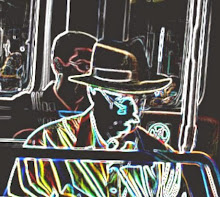I may not know what I like, but I know art when I see it ...
One of my favorite scenes in the film I, Robot is when the robot, "Sonny," tries to tell the investigating officer about his recurring dream. A picture being worth a thousand words (even to a robot), he proceeds to make a drawing to convey the scene. However he draws it like a robot might, in a series of rapid horizontal scan lines like the ones on a TV tube (remember them?) or an old dot-matrix printer. The result is uncanny -- an artistic rendering generated by a machine.
Like most science fiction this robotic trick has been quickly surpassed by reality, as you can see in this news item about Aikon, a machine that not only can draw, but does so by looking at real objects and imitating the same techniques of seeing and modeling that might be used by a human artist. I suspect that Stephen Hawking, who is himself assisted to communicate by a computer speech synthesizer, welcomes being a subject for such an experiment, as you can see in this example.
Back in the early years of computers (the 1950's) many people felt that in spite of their wizardly ability to perform mathematical calculations, there were other types of thinking that a computer would never be able to do. Alan Turing, whose work in mathematics and logic laid the groundwork for the development of the first computers, disagreed. He could find no difference in principle between what was happening in his mechanical "children" and what takes place in a human brain. Turing was one of the first to predict that computers would not only reach but surpass the abilities of those who invented them.
Oddly, in retrospect, the game of chess was sometimes sited as the kind of thing humans would always be able to do better than machines. As we know now, the opposite is true. Only the top grand masters of the game stand a chance against IBM's Deep Blue supercomputer, and most of us can't defeat a toy that sells at Radio Shack. Chess is trivial to computer analysis, and the amazing thing is that we can do as well as we do while lacking the ability to see as many moves ahead as our automated opponents.
So I for one am not the least surprised to see a portrait of Hawking that could be easily mistaken for the work of a human artist. If you play with Photoshop, or one of its alternatives like the open source GIMP, you may be familiar with the filters that can be applied to a photographic image to make it resemble an oil painting -- even to resemble a particular school of art like Impressionism or Pointillism. What Aikon does is far beyond that, actually reproducing at least some of the creative process to compose original work.
 What's that? You say Aikon doesn't feel anything? That what it produces doesn't mean anything, either to itself or those who view it? That to be art it has to convey something about human experience?
What's that? You say Aikon doesn't feel anything? That what it produces doesn't mean anything, either to itself or those who view it? That to be art it has to convey something about human experience?Maybe you should have another look at the work of Piet Mondrian, compare it to the Hawking portrait, and ask which of them looks like it was done by a human being.
Or maybe you think that feeling and expression are the kinds of things machines will never be able to do?










No comments:
Post a Comment